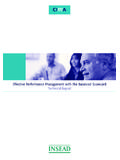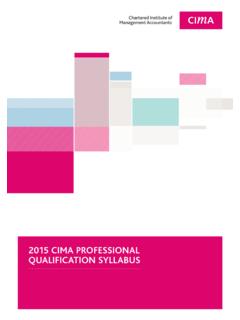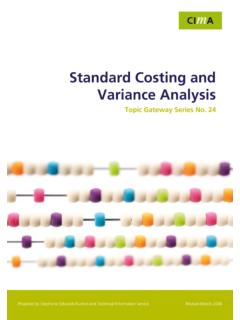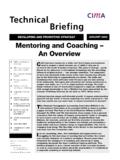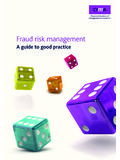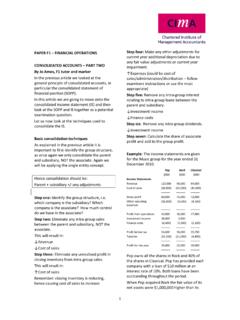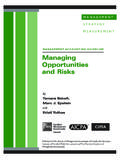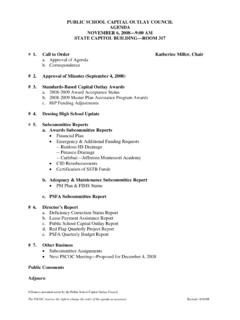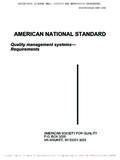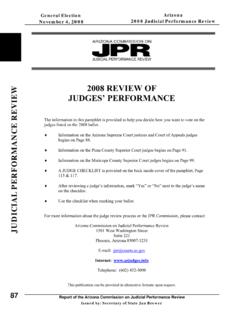Transcription of November 2008 Examinations Strategic Level Paper P3 ...
1 November 2008 Examinations Strategic Level Paper P3 Management Accounting Risk and Control Strategy Question Paper 2 Examiner s Brief Guide to the Paper 15 Examiner s Answers 17 The answers published here have been written by the Examiner and should provide a helpful guide for both tutors and students. Published separately on the CIMA website ( ) from February is a Post Examination Guide for the Paper which provides much valuable and complementary material including indicative mark information. The Chartered Institute of Management Accountants. All rights reserved. No part of this publication may be reproduced, stored in a retrieval system, or transmitted, in any form or by any means, electronic, mechanical, photocopying, recorded or otherwise, without the written permission of the publisher.
2 The Chartered Institute of Management Accountants 2008 Management Accounting Pillar Strategic Level Paper P3 Management Accounting Risk and Control Strategy 20 November 2008 Thursday Morning Session Instructions to candidates You are allowed three hours to answer this question Paper . You are allowed 20 minutes reading time before the examination begins during which you should read the question Paper and, if you wish, highlight and/or make notes on the question Paper . However, you will not be allowed, under any circumstances, to open the answer book and start writing or use your calculator during the reading time. You are strongly advised to carefully read ALL the question requirements before attempting the question concerned (that is, all parts and/or sub-questions). The question requirements are contained in a dotted box. ALL answers must be written in the answer book.
3 Answers or notes written on the question Paper will not be submitted for marking. Answer the ONE compulsory question in Section A on pages 2 to 5. Answer TWO questions only from Section B on pages 6 to 9. Maths Tables and Formulae are provided on pages 10 to 13. The list of verbs as published in the syllabus is given for reference on page 14. Write your candidate number, the Paper number and examination subject title in the spaces provided on the front of the answer book. Also write your contact ID and name in the space provided in the right hand margin and seal to close. Tick the appropriate boxes on the front of the answer book to indicate which questions you have answered. P3 Risk and Control Strategy P3 2 November 2008 SECTION A 50 MARKS [the indicative time for answering this Section is 90 minutes] ANSWER THIS QUESTION.
4 THE QUESTION REQUIREMENTS ARE ON PAGE 5, WHICH IS DETACHABLE FOR EASE OF REFERENCE Question One PLM: Background, organisational structure and financial controls PLM is one of the world s largest manufacturers of energy saving products for use in construction. The group specialises in the manufacture of timber framed sections and of insulated panels, both being used in domestic and commercial construction. The insulated panels take the form of a sandwich of outer layers of wooden board with a polystyrene core, and so PLM is very dependent on access to timber supplies for the manufacture of both of its products. PLM owns manufacturing plants and distribution centres in various locations around the world. The group is largely based in Europe, and has its headquarters and Research and Development Unit in Germany, as well as manufacturing sites in Germany, Scotland and Poland.
5 The European manufacturing operations are supported by distribution centres located in each of Germany, France and Scotland. An additional manufacturing plant and two distribution centres are located in Canada, to serve both the Canadian and US markets. PLM sells to customers located in 15 different countries in Europe and North America. The control structure in PLM is regionally rather than product based . Manufacturing and distribution centres are managed in combination as regional profit centres, whilst the Research and Development Unit is treated as a cost centre. For example, the Director of Operations for Western Europe is responsible for a single profit centre that covers the German and Scottish manufacturing plants together with the distribution centres in Germany, France and Scotland. Similarly, the Director of Operations for North America is responsible for a profit centre that includes all of the Canadian manufacturing and distribution centres.
6 The Polish manufacturing plant is a separate profit centre managed by a UK based Director. Profit centre results are calculated before inclusion of the impact of any foreign exchange or interest rate movements. Product Development The Board of Directors regards new product development as vital to the continued success of the business, and 5% of group profit is allocated to Research and Development. All new products have to obtain certification on their suitability for purpose and compliance with health and safety and building regulations. Certification is granted by an internationally approved body such as the UK based Building Research Establishment, but obtaining certification can take up to three years to complete. Environmental Issues PLM s timber based products appeal to customers because of the fact that timber is a renewable building material.
7 There is, however, growing consumer concern about illegal logging and global depletion of major forestry resources. In response to these concerns, PLM s Strategic plan states that it aims, by 2010, to have 75% of timber supplies sourced from sustainable woodland. The timber used for both the timber framed sections and the insulated panels is primarily softwood which, in forestry terms, is fast growing. Trees reach the necessary Level of maturity in approximately 20 years. Reliable market forecasts suggest that demand for sustainably produced timber is growing faster than its supply, and that severe competition for this resource will emerge over the next five to eight years. November 2008 3 P3 A number of international schemes have developed with the aim of providing customer assurance on the sustainability of a timber source. PLM uses suppliers which are registered under a number of different such schemes including the Forestry Stewardship Council, Sustainable Forestry Initiative, and the Canadian standards Association.
8 Consumers, however, appear to be poorly informed about the different assurance systems and are unable to clearly distinguish between genuine and rogue assurance schemes. Market Conditions The business has expanded very rapidly since 2000 as a result of a growing awareness amongst architects of the need to use environmentally friendly building systems, combined with the potential of both product types to halve construction times. In the 1980s and 1990s there was a degree of mistrust within the industry about the use of timber frame construction techniques, and in Europe there were only a small number of contractors who were knowledgeable and experienced in their use. In contrast, the Canadian market for the product has been well established since the 1950s. Insulated panels have also been in widespread use in North America for many years, but PLM was the first company to introduce this building system into Europe in 1998.
9 Since then a number of competitors have entered the European market, some of which provide customers with on site installation services as well as acting purely as panel manufacturers. An important reason for the market appeal of the panels lies in the fact that they offer very high levels of insulation, and the European market has expanded hugely following the introduction of strict new regulations on the energy efficiency of new buildings. The MD is aware of the impact of the 2007 credit crunch and has taken that into account when preparing the 2008 -9 budget by suggesting that there will be zero sales growth. The customer base for both timber framed sections and the insulated panels is highly concentrated. For timber framed sections, 40% of global revenue is earned in Canada, whilst 80% of PLM s substantial European revenue from the sale of the insulated panels comes from ten main construction companies.
10 Retention of key customers is pursued by PLM through its policy of guaranteeing delivery, anywhere in the world, of all orders in excess of 0 5 million, within six weeks of the order being received. As a result, there are times when PLM is manufacturing in Canada for delivery in Europe and vice versa. Sales Mix and Profit Margins Year ended 30 June 20062007 Sales: m m Global 350420 North America 150175 UK 4565 France 1010 Germany 6070 Other countries 85100 Global Ratio of timber frame to panel sales (by value)60 : 4052 : 48 Average profit margin on panels 9 5%9 0%Average profit margin on timber framed sections 12 5%14 0%P3 4 November 2008 Risk Management in PLM Overall responsibility for risk management systems within PLM rests with a senior manager (ranked immediately below Board Level ) who holds the title of Group Risk Controller.

